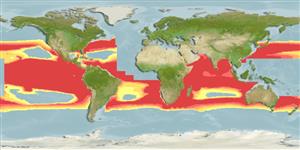>
Lampriformes (Velifers, tube-eyes and ribbonfishes) >
Lophotidae (Crestfishes)
Etymology: Eumecichthys: Greek, eumekes = very larg or long (Ref. 45335).
Eponymy: Rev George Henry Redmore Fisk (1829–1911) was a collector of South African zoological curiosities, including the holotype of this species which he sent to the BMNH. [...] (Ref. 128868), visit book page.
More on author: Günther.
Environment: milieu / climate zone / depth range / distribution range
Sinh thái học
Biển Tầng nổi biển sâu. Deep-water
Probably worldwide. Western Atlantic: southeastern Florida in USA. Southeast Atlantic: False Bay, South Africa (Ref. 4165). Northwest Pacific: Japan (Ref. 559). Eastern Central Pacific: Hawaii and Mexico (Ref. 4165). Indian Ocean: India (Ref. 4165).
Bộ gần gũi / Khối lượng (Trọng lượng) / Age
Maturity: Lm ? range ? - ? cm
Max length : 150 cm TL con đực/không giới tính; (Ref. 7251)
Các tia vây lưng cứng (tổng cộng) : 0; Tia cứng vây hậu môn: 0; Tia mềm vây hậu môn: 5 - 9. Head and body silvery in color with 24-60 dark sub vertical bands; dorsal and caudal fins crimson in color (Ref. 4165). Dorsal fin with 310-392 soft rays.
A rare (Ref. 4165), mesopelagic species found at 1,000 m depth (Ref. 5213).
Life cycle and mating behavior
Chín muồi sinh dục | Sự tái sinh sản | Đẻ trứng | Các trứng | Sự sinh sản | Ấu trùng
Heemstra, P.C., 1986. Lophotidae. p. 402-403. In M.M. Smith and P.C. Heemstra (eds.) Smiths' sea fishes. Springer-Verlag, Berlin. (Ref. 4165)
IUCN Red List Status (Ref. 130435: Version 2024-2)
Threat to humans
Harmless
Human uses
Các công cụ
Special reports
Download XML
Các nguồn internet
Estimates based on models
Preferred temperature (Ref.
123201): 7.7 - 15.1, mean 10.6 °C (based on 338 cells).
Phylogenetic diversity index (Ref.
82804): PD
50 = 1.0625 [Uniqueness, from 0.5 = low to 2.0 = high].
Bayesian length-weight: a=0.00115 (0.00043 - 0.00304), b=3.07 (2.83 - 3.31), in cm total length, based on LWR estimates for this (Sub)family-body shape (Ref.
93245).
Mức dinh dưỡng (Ref.
69278): 4.0 ±0.7 se; based on size and trophs of closest relatives
Fishing Vulnerability (Ref.
59153): Very high vulnerability (90 of 100).
